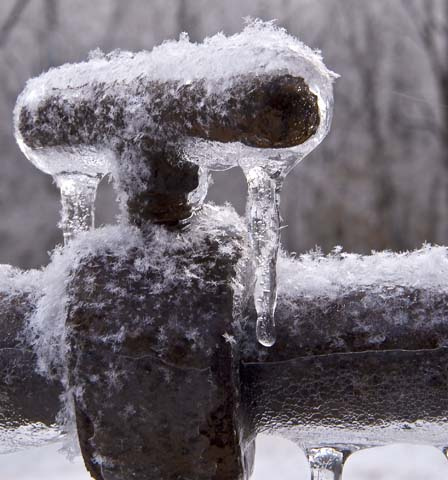Tips to Maintain Your Pipes from Freezing Damage: Important Tips
Tips to Maintain Your Pipes from Freezing Damage: Important Tips
Blog Article
Almost everyone is bound to have their own individual opinions when it comes to Prevent Frozen Pipes .

Cold weather can damage your plumbing, specifically by freezing pipelines. Below's how to prevent it from happening and what to do if it does.
Introduction
As temperatures drop, the risk of frozen pipes increases, potentially leading to pricey repairs and water damages. Recognizing just how to avoid frozen pipes is important for house owners in chilly climates.
Avoidance Tips
Protecting vulnerable pipes
Wrap pipelines in insulation sleeves or use heat tape to shield them from freezing temperatures. Focus on pipes in unheated or exterior locations of the home.
Heating techniques
Maintain interior areas sufficiently heated, particularly areas with plumbing. Open up cabinet doors to enable cozy air to circulate around pipelines under sinks.
Just how to determine icy pipelines
Search for reduced water circulation from faucets, unusual odors or sounds from pipelines, and noticeable frost on exposed pipes.
Long-Term Solutions
Structural modifications
Take into consideration rerouting pipelines far from outside wall surfaces or unheated locations. Include extra insulation to attics, basements, and crawl spaces.
Updating insulation
Buy top quality insulation for pipes, attics, and wall surfaces. Proper insulation aids preserve consistent temperature levels and decreases the threat of frozen pipelines.
Safeguarding Exterior Plumbing
Yard hose pipes and exterior faucets
Detach and drain pipes garden tubes before wintertime. Mount frost-proof spigots or cover outside taps with insulated caps.
Recognizing Icy Pipes
What creates pipelines to freeze?
Pipes ice up when subjected to temperature levels below 32 ° F (0 ° C) for expanded durations. As water inside the pipes ices up, it broadens, putting pressure on the pipeline walls and possibly causing them to rupture.
Threats and damages
Frozen pipelines can bring about water system disturbances, residential property damages, and pricey repairs. Burst pipes can flood homes and trigger substantial architectural damages.
Indicators of Frozen Piping
Recognizing icy pipes early can prevent them from bursting.
What to Do If Your Pipelines Freeze
Immediate activities to take
If you believe icy pipes, keep taps open up to eliminate stress as the ice melts. Use a hairdryer or towels taken in hot water to thaw pipes gradually.
Final thought
Avoiding icy pipes requires aggressive steps and fast actions. By understanding the reasons, signs, and safety nets, home owners can safeguard their pipes during winter.
6 Proven Ways to Prevent Frozen Pipes and Protect Your Home
Disconnect and Drain Garden Hoses
Before winter arrives, start by disconnecting your garden hoses and draining any remaining water. Close the shut-off valves that supply outdoor hose bibs and leave the outdoor faucet open to allow any residual water to drain. For extra protection, consider using faucet covers throughout the colder months. It’s also important to drain water from any sprinkler supply lines following the manufacturer’s directions.
Insulate Exposed Pipes
Insulating your pipes is an effective way to prevent freezing. Pipe insulation is readily available at home improvement stores and is relatively inexpensive. Pay close attention to pipes in unheated areas such as the attic, basement, crawl spaces, or garage. Apply foam insulation generously to create a buffer against the cold. You can also wrap your pipes in heat tape or thermostat-controlled heat cables for added warmth.
Seal Air Leaks
Inspect your home for any cracks or openings that could let in cold air. Seal any holes around the piping in interior or exterior walls, as well as the sill plates where your home rests on its foundation. Additionally, make sure to keep your garage door closed unless you’re entering or exiting. Leaving it open creates a significant air leak that can lead to frozen pipes.
Allow Warm Air Circulation
During cold snaps, it’s essential to allow warm air to circulate evenly throughout your home. Leave interior doors ajar to promote better airflow. Open kitchen and bathroom cabinets to help distribute heat consistently around the rooms. If you have small children or pets, be sure to remove any household chemicals or potentially harmful cleaners from open cabinets for safety.
Let Faucets Drip
A small trickle of water can make a big difference in preventing ice formation inside your pipes. When temperatures drop significantly, start a drip of water from all faucets served by exposed pipes. This continuous flow helps prevent the water from freezing. Additionally, running a few faucets slightly can relieve pressure inside the pipes, reducing the chances of a rupture if the water inside does freeze.
https://choateshvac.com/6-proven-ways-to-prevent-frozen-pipes-and-protect-your-home/

We were made aware of that editorial about 6 Ways to Prevent Frozen Pipes through an acquaintance on our other web blog. Be sure to take the time to distribute this blog posting if you enjoyed it. I value your readership.
Get Offer Report this page